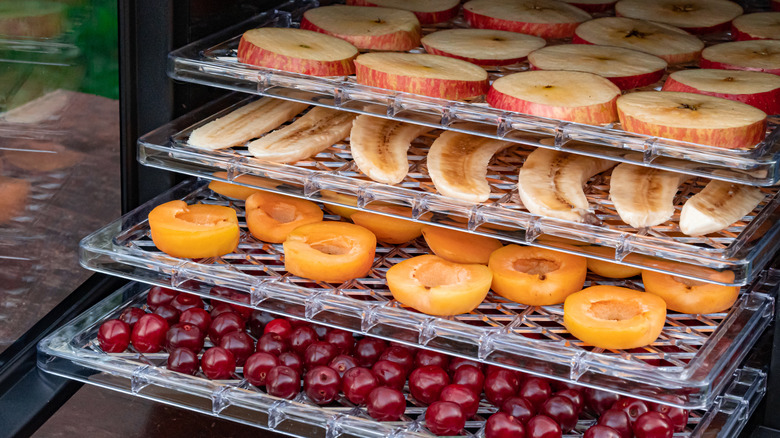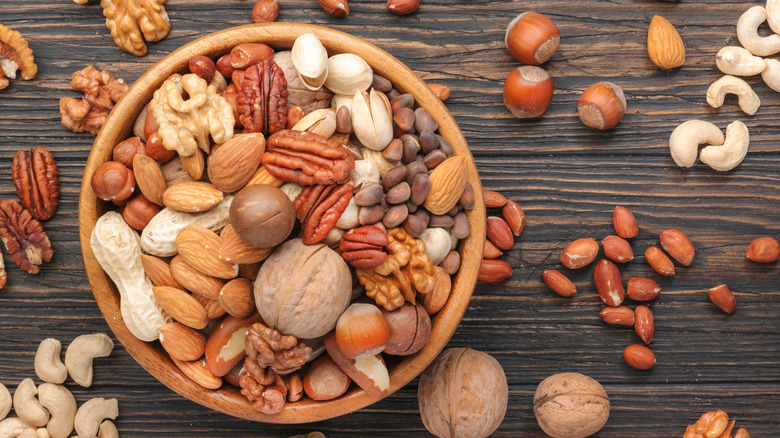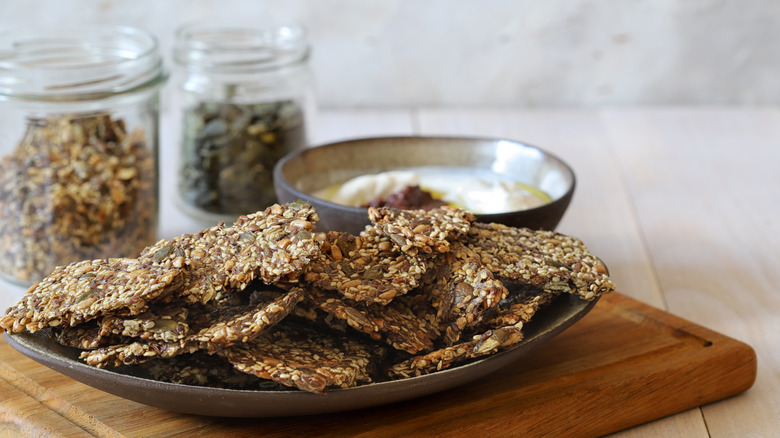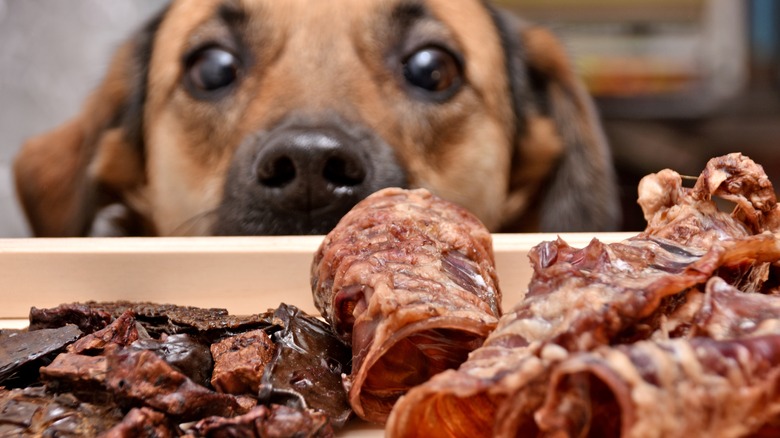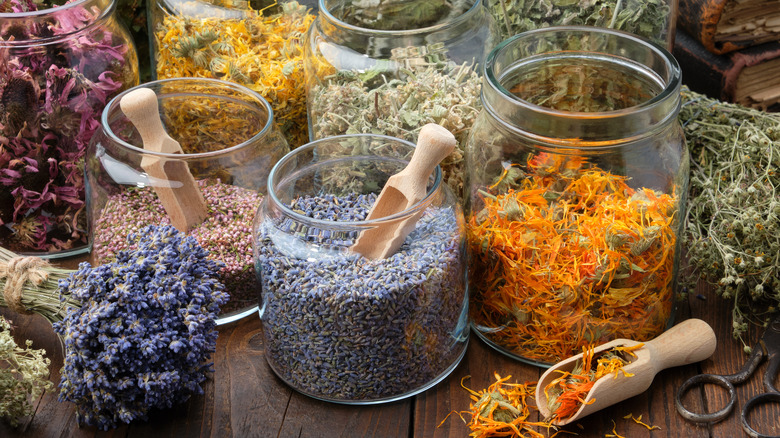The Absolute Best Uses For A Food Dehydrator
As a food preservation technique, dehydration is one of the most effective and least expensive ways to go. People have been dehydrating food since 12,000 B.C., according to the National Center for Home Food Preservation. Early dehydration techniques involving the sun and fire are still used today. Arranging racks of fruit, vegetables, and meat to bask in the sun for days or weeks until dried is one common method of dehydrating. Hanging meats near fires and smoke aid in rapid dehydration, with the smoke adding layers of flavor.
Dried fruits, vegetables, meats, flowers, and herbs have been commercially available for centuries. Grocery stores carry meat jerky, raisins, prunes, dried cranberries, apricots, and various dried and dry-roasted nuts. Still, the raw and natural food movements have increased the demand for a wider variety of dried foods. According to Healthline, drying and dehydrating concentrates the flavor, nutrients, and sugar content of most foods and can reduce bacterial and fungal contamination, particularly when heating methods are used.
Modern food dehydration techniques include oven drying, air drying, solar and electric dehydrators, smokers, and freeze driers. Drying All Foods suggests three keys for drying food: consistent warm temperatures, air circulation, and low humidity. With the advent of at-home machines, food dehydration is gaining popularity. It is easy to learn and is a versatile, money-saving method for preserving food, according to Food Revolution Network. Food dehydrators can be used in many ways, some of which might surprise you.
Fruits and vegetables
Fruits and vegetables are popular dehydrated foods. Dried fruit is better than no fruit if fresh produce isn't available. In fact, most fruits can be dried. Raisins, or dried grapes, are common in lunch boxes and cereals, and it is easy to find dried banana chips, apple slices, apricots, peaches, pineapple, coconut flakes, and all types of berries. Many commercially dried fruits contain added sugars and preservatives, however. This makes dried fruit one of the best uses for your food dehydrator; you can avoid fillers by drying your own fresh fruit. Home cooks can add dried fruits to granola and muesli for a nutritious breakfast. Try dehydrated fruit in pies, scones, muffins, or holiday fruitcakes. Or, sprinkle dried cranberries and blueberries on your salad for tangy sweetness. Purée your fruit to make fruit leather.
Dehydrating vegetables is also a versatile way to make your own nutritious versions of chips and crackers. Go beyond potato chips with thinly sliced sweet potatoes, zucchini, tomatoes, beets, or turnips. Broad, leafy greens such as kale and spinach will also make delicious chips when dried and sprinkled with seasonings. Most types of mushrooms can be dehydrated and have an extended shelflife when they are. Rare mushrooms such as morels or chanterelles are expensive and seasonal to acquire fresh, but they are available dehydrated for a fraction of the price. Interesting varieties of wild and cultivated mushrooms sourced from farmers' markets can be economical and easy to dry.
Meat, fish, and jerky
Beef jerky is ubiquitous in camping, hiking, and sportsman adventures. Most meats can be dried or made into jerky. Jerky is a popular choice for the Paleo and Keto diets and can be a nutritious addition to less specialized lifestyles as well. Commercial jerky and dried meats are filled with salt, sugar, nitrates, and other preservatives that have been shown to have negative health impacts. Make your own jerky and dried meats to avoid these unnecessary additives.
Once cut into slices or bite-sized pieces, meats and fish can be dehydrated plain or made into jerky with any flavor you can imagine. Jerky can be seasoned with herbs and spices, glazed in syrups and sauces, and can include unusual ingredients like cocoa and citrus. Create your own sweet, savory, and spicy recipes and marinate the cuts of meat or fish first before dehydrating. Also, additional flavors can be added during the dehydration process by drizzling aromatic sauces directly onto the slices of meat.
Healthline reveals that foods high in fat can be tricky to dehydrate, and the fats can turn rancid, so they suggest trimming excess fat from the cuts of meat you plan to dry. Ohio State University's extension program indicates that it is best to precook the meats to a proper internal temperature for each type to kill any bacteria or foodborne pathogens. This is crucial when dehydrating fish, fowl, and pork but is strongly recommended for cuts of beef, lamb, mutton, wild game, and bison.
Nuts, seeds, grains, and sprouted flour
Freshly harvested seeds and nuts contain a lot of moisture, which can lead to spoiled and rancid food if not stored properly. They can have harmful microbes like bacteria and fungi. Raw nuts, seeds, and grains should be refrigerated to keep them fresh and take up a lot of room in the refrigerator. Keep them fresher longer by slow roasting and dehydrating them. Nuts and seeds are packed with nutrients like antioxidants, vitamins, minerals, essential fats, and fiber and are one of the healthiest snacks, but they can be hard to digest when raw. Most nuts, seeds, and grains are suited to the heated dehydration method. Dehydrating nuts with even heat over several hours can change the texture and flavor of the nuts and seeds and can damage the healthy nutrients and oils.
Food Revolution Network suggests that soaking nuts and seeds to sprout them can make them easier to digest, and once dehydrated, sprouted nuts and seeds can be ground into healthy flours for baking. Home cooks can season nuts and seeds by tossing them in tamari sauce or flavored vinegar and sprinkling herbs and spices on them first.
Yogurt
Homemade yogurt is healthy and easy to make. MasterClass declares that making yogurt at home is as simple as selecting your milk, following a few steps, and having patience. Yogurt is commonly made with cow's milk, but you can use goat and sheep milk or milk alternatives from grain, nuts, and fruit. Milk alternatives can be trickier to thicken.
Milk is heated just below scalding and a yogurt starter comprised of two live bacteria (Lactobacillus bulgaricus and Streptococcus thermophilus) are added to start the culturing process. The fermented milk mixture is cooled slightly, poured into small glass jars with tight-fitting lids, and then kept at a constant warm temperature to allow it to thicken. A food dehydrator is a perfect environment for developing yogurt because it maintains heat consistency as long as needed. It can take up to twelve hours to fully ferment the yogurt into a creamy and smooth texture. Yogurt is delicious plain or with fruit and granola. Use your dehydrator's new product as a base for tzatziki sauce, dressings, and marinades for vegetables, fish, and meats.
Crackers, granola, and baked goods
The raw food movement is popular amongst those looking for optimal nutrient content in their foods. People still like to indulge in crunchy crackers, bread, and pastries, after all. The Rawtarian specializes in raw alternatives for traditional grain-based goodies and maintains that a food dehydrator is instrumental in creating crunchy crackers and crusty breads. Grind dehydrated nuts and seeds into flour and blend them into your favorite recipe. It is as simple as rolling out or shaping the dough into the desired form. Dehydrate the dough until cooked and crisp. Similarly, you can dehydrate pie and pizza crusts before filling and topping them to allow an even and thorough cook. Get creative with your recipes.
Likewise, making granola is as simple as tossing dried fruits, nuts, seeds, and grains, onto a drying rack and seasoning with your favorite flavors. Drizzle the mixture with a bit of maple syrup, honey, or molasses, and dehydrate for a few hours. Once cool, store granola in an airtight container in a cool location.
Pet food and treats
Don't forget about healthy homemade treats and meals for your pets. Commercial pet food is filled with grains, animal by-products, unpronounceable chemicals, and subpar ingredients that humans would never eat. Why give it to your furry best friend? Specialty and natural pet food can be expensive and sometimes hard to find, so making your own pet food and treats will give your pet something to thank you for.
Animals love fresh meat, fruits, and vegetables. The Kitchen Counter Chef suggests that green beans, apples, berries, and sweet potatoes are good choices for dried treats; so are foods like tuna, bacon, meat strips, and salmon chunks.
Raw meat isn't always healthy for pets. Precooking and dehydrating meats can be a safer option. Cut meats, vegetables, and fruit into bite-sized chunks before arranging them on dehydrator racks. Dry meats separately from fruits and vegetables as they will take longer. These little chunks can be used as treats or complete meals. If your pet prefers soft food, add some boiling water to their bowl to reconstitute the food to soften it. Be sure to cool it completely before serving it to your pet. Make tasty treats for your dogs and cats just as you would for yourself. Once you perfect your recipe, shape the dough into bite-sized pieces and dehydrate them on racks until crunchy.
Edible flowers, herbs, and ornamental plants
DIY Craft Club suggests using a food dehydrator to dry flowers and ornamental plants as a way to create décor and potpourri. Dried flowers and plants make beautiful wreaths and bouquets and can be pressed into artisanal paper for note cards and gift wrapping.
Food dehydrators are a great tool to dry culinary herbs and flowers. When picked at the optimal freshness, plants dry quickly and beautifully maintain their aromas and colors. In fact, rapid drying in a dehydrator can enhance the flavors and aromas of edible herbs and flowers. Herbs and flowers should be gently washed, patted dry, and any bruised or damaged leaves and petals should be removed before arranging the plants on drying racks. They are delicate, so keep a close eye on them during the drying process. Once dried, herbs and flowers can be used in your favorite dishes or to make tisanes.
Dried orange peels make aromatic and chemical-free fire-starters because they contain highly flammable oils, according to Dehydrator Lab. Take dried orange peels along on your next camping trip, or use them to start a cozy fire at home. They smell divine and are a safe and natural way to start fires.
